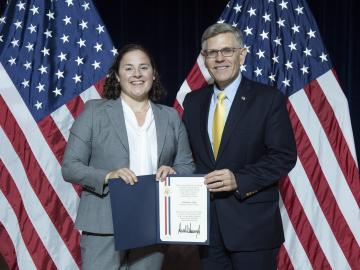
Filter News
Area of Research
- (-) Fusion Energy (2)
- (-) Materials (61)
- (-) Supercomputing (43)
- Advanced Manufacturing (3)
- Biological Systems (2)
- Biology and Environment (4)
- Clean Energy (73)
- Climate and Environmental Systems (2)
- Computer Science (2)
- Fossil Energy (1)
- National Security (3)
- Neutron Science (28)
- Nuclear Science and Technology (10)
- Quantum information Science (1)
- Renewable Energy (1)
- Transportation Systems (1)
News Type
News Topics
- 3-D Printing/Advanced Manufacturing (4)
- Advanced Reactors (1)
- Artificial Intelligence (6)
- Big Data (2)
- Bioenergy (3)
- Biomedical (2)
- Clean Water (1)
- Composites (1)
- Computer Science (16)
- Critical Materials (1)
- Cybersecurity (2)
- Energy Storage (2)
- Environment (4)
- Exascale Computing (2)
- Frontier (2)
- Fusion (2)
- Grid (1)
- Isotopes (1)
- Materials Science (7)
- Microscopy (1)
- Nanotechnology (3)
- Neutron Science (2)
- Nuclear Energy (5)
- Physics (1)
- Quantum Science (5)
- Security (1)
- Space Exploration (1)
- Summit (7)
- Sustainable Energy (4)
- Transportation (2)
Media Contacts

Artificial intelligence (AI) techniques have the potential to support medical decision-making, from diagnosing diseases to prescribing treatments. But to prioritize patient safety, researchers and practitioners must first ensure such methods are accurate.

Materials scientists, electrical engineers, computer scientists, and other members of the neuromorphic computing community from industry, academia, and government agencies gathered in downtown Knoxville July 23–25 to talk about what comes next in

Six new nuclear reactor technologies are set to deploy for commercial use between 2030 and 2040. Called Generation IV nuclear reactors, they will operate with improved performance at dramatically higher temperatures than today’s reactors.

Rare earth elements are the “secret sauce” of numerous advanced materials for energy, transportation, defense and communications applications.

Collaborators at the Department of Energy’s Oak Ridge National Laboratory and U.S. universities used neutron scattering and other advanced characterization techniques to study how a prominent catalyst enables the “water-gas shift” reaction to purify and generate hydrogen at industrial scale.

Two researchers from the Department of Energy’s Oak Ridge National Laboratory have received a 2019 Presidential Early Career Award for Scientists and Engineers, or PECASE.

Two early career researchers at the Department of Energy's Oak Ridge National Laboratory have been included on the “Periodic Table of Younger Chemists” following an international competition conducted by the International Union of Pure and Applied Chemistry (IUPAC) and the International Younger Chemists Network (IYCN).
A team of scientists led by Oak Ridge National Laboratory have discovered the specific gene that controls an important symbiotic relationship between plants and soil fungi, and successfully facilitated the symbiosis in a plant that

In the shifting landscape of global manufacturing, American ingenuity is once again giving U.S companies an edge with radical productivity improvements as a result of advanced materials and robotic systems developed at the Department of Energy’s Manufacturing Demonstration Facility (MDF) at Oak Ridge National Laboratory.
The Department of Energy’s Oak Ridge National Laboratory has named Marcel Demarteau as Physics Division Director, effective June 17.


